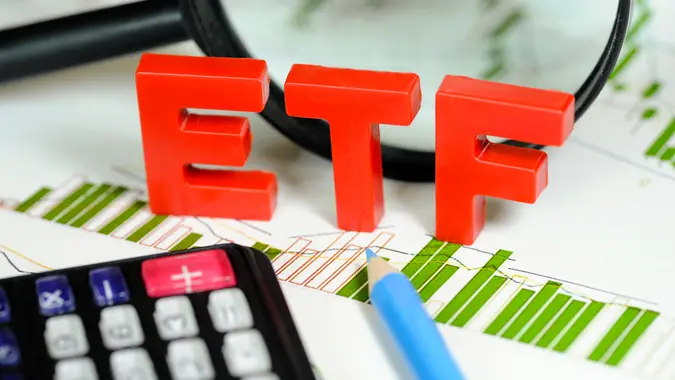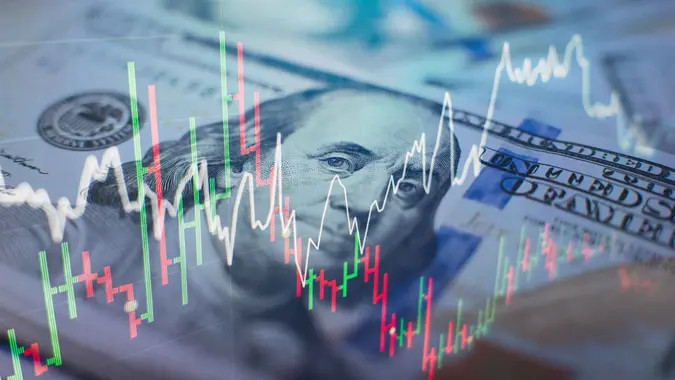7 Best Mutual Funds To Buy and Hold in a Roth IRA

Commitment to Our Readers
GOBankingRates' editorial team is committed to bringing you unbiased reviews and information. We use data-driven methodologies to evaluate financial products and services - our reviews and ratings are not influenced by advertisers. You can read more about our editorial guidelines and our products and services review methodology.

20 Years
Helping You Live Richer

Reviewed
by Experts

Trusted by
Millions of Readers
Wouldn’t it be great if there was an investment that was diversified, professionally managed, and had no tax consequences? For most investors, the answer would be a resounding yes. Fortunately, this type of investment is available to anyone, in the form of a mutual funds for Roth IRAs.
When you hold a mutual fund in a Roth IRA, you benefit from the capital appreciation and/or income payments of a fund without having to declare them on your tax return. Even if you buy and sell securities at a profit, generating a capital gain, you won’t have to pay the tax man. And when you take money out of the IRA mutual funds, it all comes out tax-free.
Top 7 Mutual Funds To Buy and Hold in Your Roth IRA
Generally speaking, investments in a Roth IRA are held for the long-term, with retirement as the primary savings objective. Depending on your age and investment objectives, a growth mutual fund, an income fund and/or a balanced fund may be appropriate. Here are some of the best mutual funds for Roth IRAs available across a number of different categories.
1. Fidelity 500 Index Fund (FXAIX)
- Assets under management: $599.39 billion
- Dividend yield: 1.22%
- Three-year return rate: 11.90%
- Expense ratio: 0.015%
- Top holdings: Apple, Microsoft, NVIDIA, Amazon, Meta Platforms
A broad-based S&P 500 index fund is a good core choice for Roth IRAs. If you’re investing for retirement in your Roth, as most people are, you’ll have time to ride out the ups and downs of the S&P 500 — which has never lost money over any rolling 20-year period. This Fidelity version has a very low expense ratio and no investment minimum, which makes it ideal for monthly investors.
2. SPDR® Portfolio S&P 500® High Dividend Fund (SPYD)
- Assets under management: $6.86 billion
- Dividend yield: 4.15%
- Three-year return rate: 10.05%
- Expense ratio: 0.07%
- Top holdings: Kellanova, BXP Inc., IBM, Stanley Black & Decker, Hasbro
The SPDR® Portfolio S&P 500® High Dividend fund invests in the 80 highest-yielding companies in the S&P 500. This provides access to quality large-cap companies and pays a high enough yield that income or balanced investors can enjoy both regular payments and capital appreciation.
3. Fidelity ZERO International Index Fund (FZILX)
- Assets under management: $4.69 billion
- Dividend yield: 2.62%
- Three-year return rate: 4.29%
- Expense ratio: 0.00%
- Top holdings: Taiwan Semiconductor, Novo-Nordisk, Tencent Holdings, ASML Holding, Nestle SA
Over the long run, it’s a good idea to get some exposure to stocks outside of the United States, and nobody does it cheaper than the Fidelity ZERO International Index Fund. As the name implies, the fund has a zero expense ratio, almost unheard of in the fund industry.
4. Victory Nasdaq-100 Index Fund (USNQX)
- Assets under management: $6.90 billion
- Dividend yield: 0.47% (trailing)
- Three-year return rate: 11.39%
- Expense ratio: 0.42%
- Top holdings: Apple, Microsoft, NVIDIA, Broadcom, Meta Platforms
This fund tracks the extremely popular Nasdaq-100 index, which consists of the 100 largest non-financial companies in the NASDAQ index. Although it’s not strictly a technology fund, the most popular technology companies in the world comprise nearly 50% of the fund’s weighting.
5. T. Rowe Price Balanced Fund (RPBAX)
- Assets under management: $4.78 billion
- Dividend yield: 1.94% (trailing)
- Three-year return rate: 5.08%
- Expense ratio: 0.60%
- Top holdings: TRP Institutional High Yield – Institutional, TRP Real Assets, Microsoft, NVIDIA, Apple
The T. Rowe Price Balanced Fund is a bit different than your traditional 60% stock/40% bond fund. It incorporates more diverse asset classes, including international stocks and high-yield, and boosts its stock portion to 65%. Overall, that should help with diversification. The fund carries 4 stars from Morningstar.
6. Schwab Total Stock Market Index Fund (SWTSX)
- Assets under management: $26.13 billion
- Dividend yield: 1.17%
- Three-year return rate: 10.11%
- Expense ratio: 0.03%
- Top holdings: Apple, Microsoft, NVIDIA, Amazon, Meta Platforms
If you’re looking for instant diversification in a mutual fund, the Schwab Total Stock Market Index Fund is a good option. The fund tracks the total return of the entire U.S. stock market, from large-cap to micro-cap, consisting of over 3,000 securities.
7. Credit Suisse Strategic Income Fund (CSOIX)
- Assets under management: $836.9 million
- Dividend yield: 7.80%
- Three-year return rate: 5.14%
- Expense ratio: 0.79%
- Top holdings: Hub International Limited 2024 Term Loan B, UFC Holdings LLC 2021 Term Loan B, IRB Holding Corp. 2024 Term Loan B, Project Alpha Intermediate 2024 Term Loan B, Northern Oil and Gas Inc. 8.125%
A strategic income bond fund shouldn’t be a huge percentage of your total portfolio because the high-yield investments these types of funds own carry additional risk. However, a strategic income fund can provide both some level of diversification and a high level of income that you can either distribute or reinvest, depending on your needs, age and financial situation. This fund, rated 5 stars by Morningstar, is one of the best.
Understanding Mutual Funds
A mutual fund is a shared pool of investments. When you buy shares in a mutual fund, professional managers take your money, commingle it with money from other investors and use that mutual pool to buy stocks, bonds or other securities with it. Each shareholder owns a percentage of the investments bought by the fund in proportion to the size of their investment.
One of the main benefits of a mutual fund is that it can offer instant diversification. With a single purchase, you can own shares of hundreds of different stocks, for example, all professionally selected and managed in accordance with the written objectives of the fund. This also eliminates the need for individual investors to research hundreds of different securities on their own.
Final Take: Why Mutual Funds Are a Strong Choice for Roth IRAs
Owning mutual funds in a Roth IRA allows you to easily automate your retirement savings. You can set up monthly deposits to your Roth that go straight into your mutual funds and build up value over time. You won’t be taxed on any income or capital gains distributions your funds make, even if you reinvest them. Mutual funds also come with the convenience of instant diversification without having to do your own research into which securities to select.
Knowing how much to put in mutual funds in an IRA depends on your goals, but getting started with one of these options can be an important step toward securing your financial future.
FAQ
- Is a Roth IRA a mutual fund?
- No, a Roth IRA is a type of investment account. A mutual fund is a type of investment you can hold in your Roth IRA.
- Are mutual funds good for Roth IRAs?
- Mutual funds can be a great investment for a Roth IRA. Thanks to the tax benefits of the account, your income and gains are protected. They're also tailor-made for automated investments.
- What should I fund my Roth IRA with?
- You should fund your Roth IRA with your earned income. Rather than keeping it in a savings account, you can invest for the long run and potentially earn a higher return.
- How can I maximize my Roth IRA?
- You can maximize your Roth IRA by contributing the limit every year, which is $7,000 for most investors and $8,000 for those 50 and older. Investing prudently according to your financial objectives and risk tolerance is the best way to optimize your long-term return.
- What are the best mutual funds for retirees?
- The best funds for one retiree won't necessarily be the best funds for another. Base your investment decisions on your financial goals and your risk tolerance. If in doubt, consult with a fee-based financial advisor.
Daria Uhlig contributed to the reporting for this article.
Data is accurate as of Oct. 16, 2024, and is subject to change.
Editorial Note: This content is not provided by any entity covered in this article. Any opinions, analyses, reviews, ratings or recommendations expressed in this article are those of the author alone and have not been reviewed, approved or otherwise endorsed by any entity named in this article.
Our in-house research team and on-site financial experts work together to create content that’s accurate, impartial, and up to date. We fact-check every single statistic, quote and fact using trusted primary resources to make sure the information we provide is correct. You can learn more about GOBankingRates’ processes and standards in our editorial policy.
- Fidelity Fund Research. "Fidelity Freedom Index 2055 Fund."
- Morningstar. "Fidelity ZERO Large Cap Index."
- Schwab Asset Management. "Schwab Total Stock Market Index."
- Morningstar. "SPDR Portfolio S&P 500 ETF."
- Fidelity Fund Research. "Fidelity ZERO International Index Fund."
- Morningstar. "USAA Nasdaq-100 Index Fund."
- Morningstar. "Vanguard Balanced Index Fund."
- Morningstar. "3 Great Balanced Funds"
 Written by
Written by  Edited by
Edited by 

























